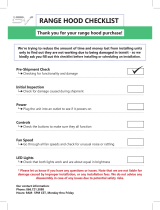
1
Important Information
• The Important Safety Instructions and warnings in
these instructions are not meant to cover all possible
problems and conditions that can occur. Use common
sense and caution when installing, maintaining, or operat-
ing this or any other appliance.
• Always contact Dacor Customer Assurance about issues
you cannot resolve.
Safety Alerts
When you see these alerts in the manual, read the
message carefully before continuing.
DANGER
Immediate hazards that WILL result in severe personal injury or
death.
WARNING
Hazards or unsafe practices that COULD result in severe
personal injury or death.
CAUTION
Hazards or unsafe practices that MIGHT result in minor
personal injury or property damage.
General Safety Precautions
To reduce the risk of fire, electric shock, serious injury or
death when using your appliance, follow basic safety pre-
cautions, including the following:
CAUTION
For general ventilating use only. Do not use to exhaust
hazardous or explosive materials and vapors.
WARNING
To reduce risk of fire, electric shock, and personal injury:
• Installation work and electrical wiring must be done by
qualified personnel according to applicable codes and
standards, including fire-rated construction.
• Sufficient air is needed for proper combustion and exhaust of
gases out the chimney of fuel-burning equipment to prevent
backdraft. Follow the heating equipment manufacturer’s
guideline and safety standards such as those published by the
National Fire Protection Association (NFPA), and the American
Society for Heating, Refrigeration and Air Conditioning
Engineers (ASHRAE), and the local code authorities.
• Know the location of utilities before cutting/drilling into a wall or
ceiling.
• Ducted fans must always be vented to the outdoors.
Important Safety Instructions
WARNING
To reduce risk of fire, electric shock, and personal injury:
• Use this unit only as intended by the manufacturer. If you have
questions, contact the manufacturer.
• Before servicing/cleaning unit, turn off power at the service
panel, and lock the panel to prevent power from being turned
on. If locking the panel is not an option, securely fasten a
prominent warning device, such as a tag, to the panel.
DANGER
To avoid risk of explosion or fire, do not store/use combustible,
flammable substances (ex: gasoline) in/on/near this appliance.
Keep items that could explode (ex: aerosol cans) away from
cooking units and hoods.
WARNING
• To avoid property damage, personal injury, or death from fire
or explosion, follow the directions in this manual precisely.
• Do not install the unit if it dropped, was damaged in some
way, or malfunctions. If the product is damaged when
received, immediately contact the dealer or builder.
• The unit must be installed and grounded by a qualified install-
er as instructed in this manual.
• Install the unit only per the instructions and requirements
specified by the manufacturer of the cooking unit. Not doing
so can cause serious personal injury and property damage.
• The user should install/repair/replace components only as
specifically recommended in the provided manuals. A quali-
fied technician should perform all other service. Contact the
nearest Dacor authorized service representative at (800)
793-0093, or at www.dacor.com for examination, repair, or
adjustment.
• Keep all packaging materials away from children.
• Do not use an extension cord or adapter plug.
• The installer must show the user the fuse box or circuit-
breaker panel so power can be turned on/off as needed.
• Do not tamper with the controls.
• If the cooktop and hood are near a window, do not hang win-
dow coverings that could blow over the cooktop and hood.
• Always run the fan(s) whenever the cooktop is operating.
• Never leave the range or cooktop unattended when a burner
(or element) is in use. Boil-overs and greasy spills may
smoke and/or ignite.
• Do not leave children unattended near the active cooktop
and hood. Never let children sit/stand on an appliance or play
with the cooking unit or hood. Do not store items of interest to
children above/on/near the appliances.
• The minimum distance between cooking surface and hood
bottom must be at least 30” (76.2 cm).
• USE ONLY METAL DUCTWORK.
• Do not try to use this appliance during a power outage.























